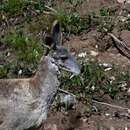en
names in breadcrumbs


The caudal gland located at the base of the tail secretes a foul smelling viscous yellow substance (Green,1985-1987).
The musk pod is located only in males, and secretes musk (Sathyakumar, 1993). The musk is of highest quality during mating season which is from December to January. During this time, it is a dark red brown granular powder with a strong smell. During November, April, and June, the musk quality is poorer. It has a pasty appearance, its color is creamy white, and it has little smell (Shrestha,1989). The external musk pod is roughly 4.1cm long, 3.3cm wide, and 4.6cm deep (Shrestha,1989).
Perception Channels: tactile ; chemical
CITES Appendix I Afghanistan, India, Nepal, Pakistan
Appendix II Bhutan, China
The M. chrysogaster population around the Himalayan area has decreased greatly because of poaching animals for their musk and the destruction of natural habitats both by livestock and by local people who collect bamboo for domestic use (Sathyakumar,1993).
One method of conserving M. chrysogaster is by extracting the musk without killing the musk deer. However, this method takes more time, and is more traumatizing for the musk deer (Shrestha,1989). Musk deer farms are used for this purpose, but these farms have high mortality rates. The main causes of deaths in these farms are trauma, pneumonia and diarrhea (Sathyakumar,1993).
Some problems that may contribute to the high mortality rate are low quality buildings, poor equipment, lack of adequate money, lack of skilled workers, and the remoteness and cold climate of the farm location (Sathyakumar,1993).
In China, there has been reports of success in cutting down mortality rate in Dwarf musk deer farms. In Fozling Farm, Anhui, the survival of young increased from 50% to >90%. In Ma Er Kang Farm, Sichuan, the young survival rate was 74% from 1959 to 1973 for three hundred and thirty-six Dwarf musk deer (Sathyakumar, 1993).
The reasons for keeping musk deer farms are for musk production, research, reintroduction into wild, and reintroduction to existing wild populations (Sathyakumar,1993).
US Federal List: endangered
CITES: appendix i
IUCN Red List of Threatened Species: endangered
The musk is used by humans to make soap, perfume (Myers,1999) and indigenous medicine (Sathyakumar,1993).
Positive Impacts: source of medicine or drug
M. chrysogaster is a ruminant (Sathyakumar,1993). It can live on poor quality food. In autumn and winter, it mostly eats forbs and the woody plant leaves of trees and shrubs such as oak and gaultheria. In spring and summer, its diet consists mainly of forbs and lichens (Green,1987).
Plant Foods: leaves; lichens
Primary Diet: herbivore (Folivore )
Moschus chrysogaster lives along the Himalayas in Nepal, northern India, southern China, Afghanistan, Bhutan, and Pakistan (CITES,2001; Shrestha,1989; Sathyakumar,1993; Kattel,1991).
M. chrysogaster usually lives in forests with moderate to steep slopes (Kattel,1991). M. chrysogaster is found in oak or fir forests (Kattel,1991) and can be found up to the tree line (usually about 4500 m) in mountains. Plants that may be found in its habitat include birch, rhododendron, blue pine, fir, oak, juniper, grass, lichens and shrubs (Kattel,1991; Green,1987).
Range elevation: 2400 to 4500 m.
Habitat Regions: temperate ; terrestrial
Terrestrial Biomes: forest ; scrub forest ; mountains
The average lifespan of captive bred M. chrysogaster is 2.4 years. The average lifespan of wild caught captive M. chrysogaster is about 7 years. The oldest captive Dwarf musk deer (M. berezovskii) from China had a lifespan of 20 years (Sathyakumar,1993).
Range lifespan
Status: captivity: 17 (high) years.
Average lifespan
Status: wild: 3.1 years.
Average lifespan
Status: captivity: 2.4 years.
M. chrysogaster looks like a small deer with long upper canines that are visible even when the mouth is closed. It's tail is hairless except for a small tuff at the end (Shrestha, 1989), and it has long "hare-like" ears (Sathyakumar,1993). It has an externally visible musk sac that lies between its reproductive organs and umbilicus (Shrestha, 1989). The opening to the sac lies anterior to the urethra (Shrestha, 1989). A musk deer is about 60cm tall and has a shoulder height of about 20cm (Shrestha, 1989).
Musk deer have a caudal gland at the base of their tails (Green,1985-1987).
Range mass: 10 to 15 kg.
Average length: 100 cm.
Other Physical Features: endothermic ; bilateral symmetry
M. chrysogaster has a shy nature (Sathyakumar,1993), and is easily alarmed (Kattel,1991). It is a solitary animal (Sathyakumar,1993) that is wary of humans.
Known Predators:
The mating season is December to January (Shrestha,1989).
Key Reproductive Features: gonochoric/gonochoristic/dioecious (sexes separate); sexual
Average birth mass: 800 g.
Average number of offspring: 1.
Average age at sexual or reproductive maturity (female)
Sex: female: 639 days.